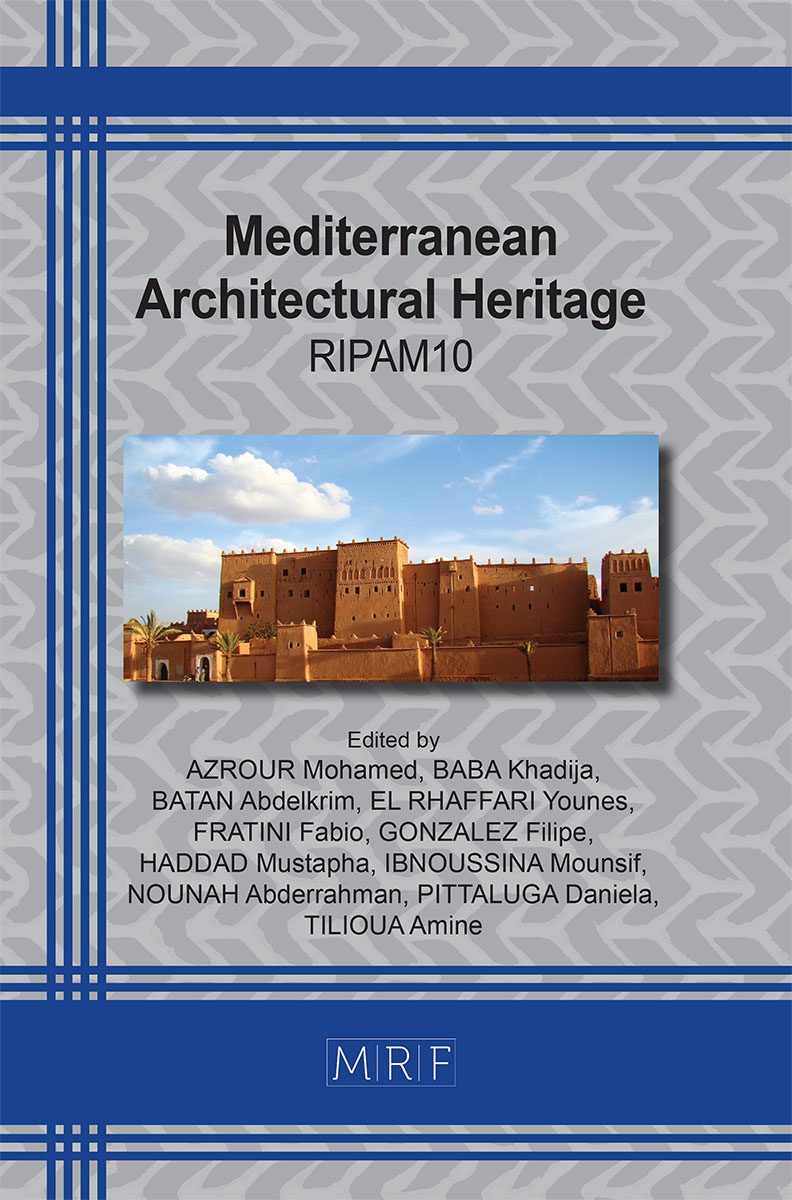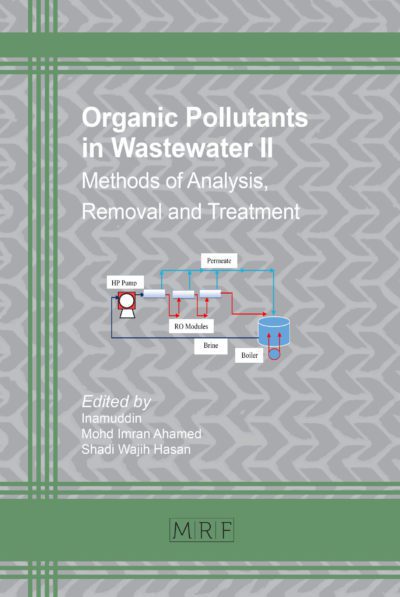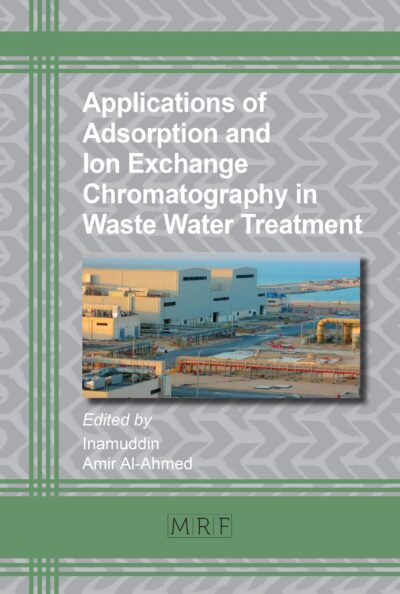Application of Raw Moroccan Clay as a Potential Adsorbent for the Removal of Malachite Green Dye from an Aqueous Solution: Adsorption Parameters Evaluation and Thermodynamic Study
Mohammed CHRACHMY, Rajae GHIBATE, Najia EL HAMZAOUI, Mahdi LECHHEB, Hassan OUALLAL, Mohamed AZROUR
download PDFAbstract. This study uses raw clay from the Es-sifa (REC) territorial commune in the region of Draa-Tafilalet, Morocco, for malachite green (MG) adsorption from an aqueous medium. The characterization of clay was ensured by Fourier Transform Infrared (FTIR) spectroscopy, X-ray diffraction (XRD), and determining the Point of Zero Charge pH. Moreover, five parameters were considered to regulate the adsorption process, including time of contact, initial dye concentration, mass of the adsorbent, stirring speed, and temperature. The finding displayed that equilibrium was reached after only 40 minutes of contact. The maximum adsorption amount achieved was 89.61 mg/g for a dye concentration of 10-4 M at 25 °C, using a REC mass of 0.10 g. According to the thermodynamic study, the endothermicity and spontaneity of MG adsorption were disclosed. Malachite green’s fixation on the REC surface was verified by comparing the clay FTIR spectra before and after adsorption.
Keywords
Raw Clay, Adsorption, Malachite Green, Parameters Effects, Thermodynamic Study
Published online 3/15/2024, 12 pages
Copyright © 2024 by the author(s)
Published under license by Materials Research Forum LLC., Millersville PA, USA
Citation: Mohammed CHRACHMY, Rajae GHIBATE, Najia EL HAMZAOUI, Mahdi LECHHEB, Hassan OUALLAL, Mohamed AZROUR, Application of Raw Moroccan Clay as a Potential Adsorbent for the Removal of Malachite Green Dye from an Aqueous Solution: Adsorption Parameters Evaluation and Thermodynamic Study, Materials Research Proceedings, Vol. 40, pp 248-259, 2024
DOI: https://doi.org/10.21741/9781644903117-27
The article was published as article 27 of the book Mediterranean Architectural Heritage
![]() Content from this work may be used under the terms of the Creative Commons Attribution 3.0 license. Any further distribution of this work must maintain attribution to the author(s) and the title of the work, journal citation and DOI.
Content from this work may be used under the terms of the Creative Commons Attribution 3.0 license. Any further distribution of this work must maintain attribution to the author(s) and the title of the work, journal citation and DOI.
References
[1] A. Kausar, M. Iqbal, A. Javed, K. Aftab, Z.-H. Nazli, H.N. Bhatti, S. Nouren, Dyes adsorption using clay and modified clay: A review, J. Mol. Liq. 256 (2018) 395–407. https://doi.org/10.1016/j.molliq.2018.02.034
[2] D.L. Carter, M.M. Mortland, W.D. Kemper, Specific Surface, in: Arnold Klute (Eds), Methods of Soil Analysis: Part 1 Physical and Mineralogical Methods, John Wiley & Sons, Ltd, 1986, pp. 413–423. https://doi.org/10.2136/sssabookser5.1.2ed.c16
[3] X. Jia, J. Li, E. Wang, Lighting-up of the dye malachite green with Mercury(II)–DNA and its application for fluorescence turn-off detection of cysteine and glutathione, Chem. Eur. J. 18 (2012) 13494–13500. https://doi.org/10.1002/chem.201103768
[4] A. Khodabakhshi, M.M. Amin, Determination of malachite green in trout tissue and effluent water from fish farms, Int. J. Environ. Health Eng. 1 (2012) 51–56.
[5] Z. Hicham, Z. Bencheqroun, I.E. Mrabet, M. Kachabi, M. Nawdali, I. Neves, Removal of basic dyes from aqueous solutions by adsorption onto Moroccan clay (Fez city), Mediterr. J. Chem. 8 (2019) 158–167. https://doi.org/10.13171/mjc8319050803hz
[6] H. Ouallal, M. Azrour, M. Messaoudi, H. Moussout, L. Messaoudi, N. Tijani, Incorporation effect of olive pomace on the properties of tubular membranes, J. Environ. Chem. Eng. 8 (2020) 103668. https://doi.org/10.1016/j.jece.2020.103668
[7] S. Mahmoudi, A. Bennour, A. Meguebli, E. Srasra, F. Zargouni, Characterization and traditional ceramic application of clays from the Douiret region in South Tunisia, Appl. Clay Sci. 127–128 (2016) 78–87. https://doi.org/10.1016/j.clay.2016.04.010
[8] I. Akhrif, L. Mesrar, M.E. Jai, M. Benhamou, R. Jabrane, Elaboration and X-Ray Diffraction Techniques Characterization of clay-PEG 6000 Nanocomposites with clay Matrix, Int. J. Multidiscip. Current Res. 3 (2015) 564–571.
[9] P.E. Tsakiridis, M. Samouhos, M. Perraki, Valorization of dried olive pomace as an alternative fuel resource in cement clinkerization, Constr Build Mater. 153 (2017) 202–210. https://doi.org/10.1016/j.conbuildmat.2017.07.102
[10] N. Kaya, M. Atagur, O. Akyuz, Y. Seki, M. Sarikanat, M. Sutcu, M.O. Seydibeyoglu, K. Sever, Fabrication and characterization of olive pomace filled PP composites, Compos. B: Eng. 150 (2018) 277–283. https://doi.org/10.1016/j.compositesb.2017.08.017
[11] T. Sheela, Y.A. Nayaka, Kinetics and thermodynamics of cadmium and lead ions adsorption on NiO nanoparticles, Chem. Eng. J. 191 (2012) 123–131. https://doi.org/10.1016/j.cej.2012.02.080
[12] D. Hank, Z. Azi, S. Ait Hocine, O. Chaalal, A. Hellal, Optimization of phenol adsorption onto bentonite by factorial design methodology, J. Ind. Eng. Chem. 20 (2014) 2256–2263. https://doi.org/10.1016/j.jiec.2013.09.058
[13] O. Abdelwahab, N.K. Amin, Adsorption of phenol from aqueous solutions by Luffa cylindrica fibers: Kinetics, isotherm and thermodynamic studies, Egypt. J. Aquat. Res. 39 (2013) 215–223. https://doi.org/10.1016/j.ejar.2013.12.011
[14] V. Zaspalis, A. Pagana, S. Sklari, Arsenic removal from contaminated water by iron oxide sorbents and porous ceramic membranes, Desalination. 217 (2007) 167–180. https://doi.org/10.1016/j.desal.2007.02.011
[15] J.R.O. Kikouama, K.L. Konan, A. Katty, J.P. Bonnet, L. Baldé, N. Yagoubi, Physicochemical characterization of edible clays and release of trace elements, Appl. Clay Sci. 43 (2009) 135–141. https://doi.org/10.1016/j.clay.2008.07.031
[16] A. Qlihaa, S. Dhimni, F. Melrhaka, N. Hajjaji, A. Srhiri, Caractérisation physico-chimique d’une argile Marocaine [Physico-chemical characterization of a morrocan clay], J. Mater. Environ. Sci. 7 (2016) 1741-1750.
[17] P. Sabbatini, F. Rossi, G. Thern, A. Marajofsky, M.M.F. de Cortalezzi, Iron oxide adsorbers for arsenic removal: A low cost treatment for rural areas and mobile applications, Desalination. 248 (2009) 184–192. https://doi.org/10.1016/j.desal.2008.05.104
[18] K.P. Raven, A. Jain, R.H. Loeppert, Arsenite and Arsenate Adsorption on Ferrihydrite: Kinetics, equilibrium, and adsorption envelopes, Environ. Sci. Technol. 32 (1998) 344–349. https://doi.org/10.1021/es970421p
[19] R. Ghibate, O. Senhaji, R. Taouil, Valuation of Pomegranate Peel for Cationic Dye Removal, Int. J. Eng. Res. Appl. 10 (2020) 19–22.
[20] R. Ghibate, F. Sabry, O. Senhaji, R. Taouil, M. Touzani, State of the art of technologies for Zn2+ ions removal from industrial effluents with adsorption: Examination of process parameters (Part I), Int. J. Innov. Res. Technol. Sci. Eng. 2 (2015) 39–48.
[21] R. Ghibate, O. Senhaji, R. Taouil, Kinetic and thermodynamic approaches on Rhodamine B adsorption onto pomegranate peel, Case Stud. Chem. Environ. Eng. 3 (2021) 100078. https://doi.org/10.1016/j.cscee.2020.100078.
[22] M. Messaoudi, M. Douma, N. Tijani, Y. Dehmani, L. Messaoudi, Adsorption process of the malachite green onto clay: Kinetic and thermodynamic studies, Desalination Water Treat. 240 (2021) 191–202. https://doi.org/10.5004/dwt.2021.27688
[23] E. Bazrafshan, P. Amirian, A.H. Mahvi, A. Ansari-Moghaddam, Application of adsorption process for phenolic compounds removal from aqueous environments: a systematic review, Glob. Nest J. 18 (2016) 146–163. https://doi.org/10.30955/gnj.001709
[24] A. Witek‐Krowiak, R.G. Szafran, S. Modelski, A. Dawiec, Removal of cationic dyes from aqueous solutions using microspherical particles of fly ach, Water Environ. Res. 84 (2012) 162–170. https://doi.org/10.2175/106143011X13233670703657
[25] Y.C. Sharma, Adsorption characteristics of a low-cost activated carbon for the reclamation of colored effluents containing malachite green, J. Chem. Eng. Data. 56 (2011) 478–484. https://doi.org/10.1021/je1008922
[26] A.R. Tehrani-Bagha, H. Nikkar, N.M. Mahmoodi, M. Markazi, F.M. Menger, The sorption of cationic dyes onto kaolin: Kinetic, isotherm and thermodynamic studies, Desalination. 266 (2011) 274–280. https://doi.org/10.1016/j.desal.2010.08.036
[27] M. Saleh, M. Yalvaç, H. Arslan, M. Gün, Malachite green dye removal from aqueous solutions using Invader Centaurea Solstitialis plant and optimization by response surface method: Kinetic, isotherm, and thermodynamic study, Eur. J. Sci. Tech. (2019) 755–768. https://doi.org/10.31590/ejosat.643238
[28] A. Mittal, Adsorption kinetics of removal of a toxic dye, Malachite Green, from wastewater by using hen feathers, J. Hazard. Mater. 133 (2006) 196–202. https://doi.org/10.1016/j.jhazmat.2005.10.017
[29] P. Janoš, Sorption of basic dyes onto iron humate, Environ. Sci. Technol. 37 (2003) 5792–5798. https://doi.org/10.1021/es020142o.
[30] S.S. Tahir, N. Rauf, Removal of a cationic dye from aqueous solutions by adsorption onto bentonite clay, Chemosphere. 63 (2006) 1842–1848. https://doi.org/10.1016/j.chemosphere.2005.10.033
[31] V.K. Gupta, S.K. Srivastava, D. Mohan, Equilibrium uptake, sorption dynamics, process optimization, and column operations for the removal and recovery of malachite green from wastewater using activated carbon and activated slag, Ind. Eng. Chem. Res. 36 (1997) 5545–5545. https://doi.org/10.1021/ie970824y
[32] S.D. Khattri, M.K. Singh, Colour Removal from dye wastewater using sugar cane dust as an adsorbent, Adsorpt. Sci. Technol. 17 (1999) 269–282. https://doi.org/10.1177/026361749901700404














